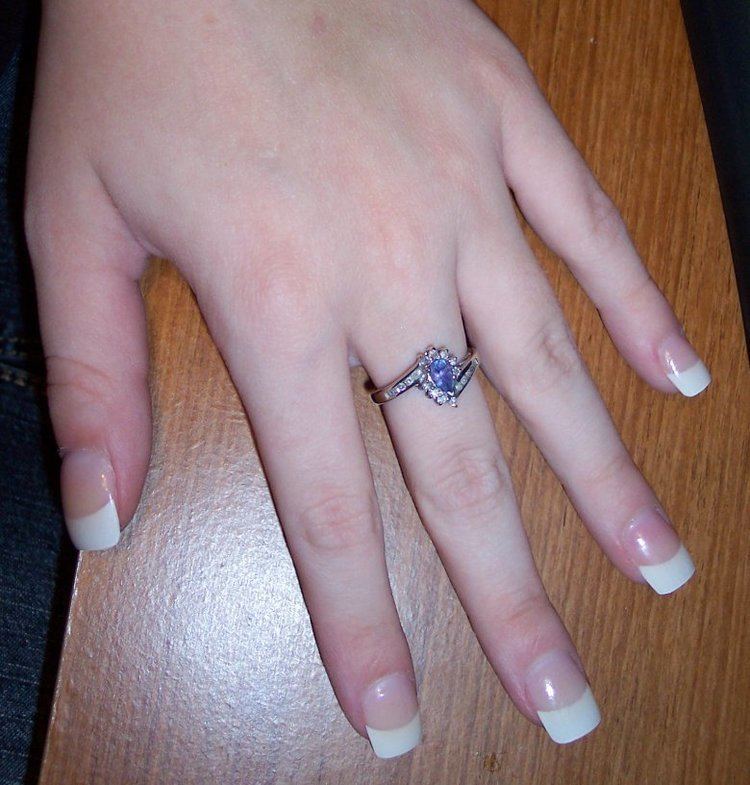 | ||
A manicure is a cosmetic beauty treatment for the fingernails and hands, performed at home or in a nail salon. A manicure consists of filing and shaping of the free edge, pushing (with a cuticle pusher) and clipping (with cuticle nippers) any nonliving tissue (limited to cuticle and hangnails), treatments, massage of the hand, and the application of fingernail polish. When applied to the toenails and feet, this treatment is referred to as a pedicure.
Contents
- Etymology
- Nail trends
- History
- French manicures
- Hot oil manicures
- Paraffin wax treatments
- Common manicure tools and supplies
- Sanitation options
- Shape
- New York Controversy
- References
Some manicures can include the painting of pictures or designs on the nails, or applying small decals or imitation jewels. Other nail treatments may include the application of artificial nail gel nails, tips, or acrylics, some of which are referred to as French manicures.
In many areas, manicurists are licensed and follow regulations. Since skin is manipulated and is sometimes trimmed, there is a certain risk of spreading infection when tools are used across many people; therefore, sanitation is a serious issue.
Etymology
The English word manicure comes from the French word manucure, meaning "care of the hands", which in turn originates from the Latin words manus, for "hand", and cura, for "care". Similarly, the English word pedicure comes from the Latin words ped, for "foot", and cura, for "care".
Nail trends
The popularity and fascination with nail art has increased in recent years due to a flourishing online community that shares tips, tricks and designs via social media sites like Facebook, Instagram, Tumblr, and Pinterest.
History
Manicures began 5,000 years ago.
French manicures
Jeff Pink founder of professional nail brand Orly is famed with creating the Natural nail look later called the French manicure in 1976.
French manicures can be made with artificial nails, which are designed to resemble natural ones and are characterized by lack of base color, or natural pink base nails with white tips. The nail tips are painted white, while the rest of the nails are polished in a pink or a suitable nude shade. However, it is also as common to perform a French manicure on natural nails. Another technique is to whiten the underside of the nail with white pencil and paint a sheer color over the entire nail.
Hot oil manicures
A hot oil manicure is a specific type of manicure that cleans the cuticles and softens them with oil. Types of oils that can be used are mineral oil, olive oil, some lotions or commercial preparations in an electric heater.
Paraffin wax treatments
Hands can be dipped in melted paraffin wax for softening and moisturizing. Paraffin wax is used because it can be heated to temperatures of over 95 °F (35 °C) without burning or injuring the hand. The intense heat allows for deeper absorption of emollients and essential oils. The wax is usually infused with various botanical ingredients such as aloe vera, azulene, chamomile, or tea tree oil, and fruit waxes such as apple, peach, and strawberry, are often used in salons. Paraffin wax treatments are often charged in addition to the standard manicure nail treatments . As such, they are often not covered in general training and are a rare treatment in most nail salons.
Occasionally, lotion is rubbed on the hand before submersion into the paraffin bath. The hand is usually dipped more than once to allow a thicker wax coat to form, making the coating stay warm longer and less likely to break or tear prematurely. After the hands have been dipped in the wax, they are wrapped in either plastic or aluminum foil, or a special type of plastic bag or glove, then covered with a towel or special mitten to retain warmth. The hands are left for a few minutes before the paraffin is cooled and dried.
Common manicure tools and supplies
Common manicure/pedicure tools include:
Common manicure/pedicure supplies include:
For decoration (optional):
Sanitation options
In Australia, the United States, and other countries, many nail salons offer personal nail tool kits for purchase to avoid some of the sanitation issues in the salon. The kits are often kept in the salon and given to the client to take home, or are thrown away after use. They are only used when that client comes in for a treatment.
Another option is to give the client the files and wooden cuticle sticks after the manicure. Since the 1970s, the overwhelming majority of professional salons use electric nail files that are faster and yield higher quality results, particularly with acrylic nail enhancements.
Shape
There are several nail shapes: the basic shapes are almond, oval, pointed, round, square, square oval, square with rounded corners, and straight with a rounded tip. The square oval shape is sometimes known as a "squoval", a term coined in 1984. The squoval is considered a sturdy shape, useful for those who work with their hands.
New York Controversy
On May 7, 2015, The New York Times journalist Sarah Maslin Nir broke the two-part story titled "The Price of Nice Nails" and "Perfect Nails, Poisoned Workers" about abuses in New York salons related to ill-treatment of workers and associated health risks. As a result, on May 11, 2015, New York governor Andrew Cuomo took immediate measures announcing a Multi-Agency Enforcement Task Force to tackle the abuse in the nail salon industry.
